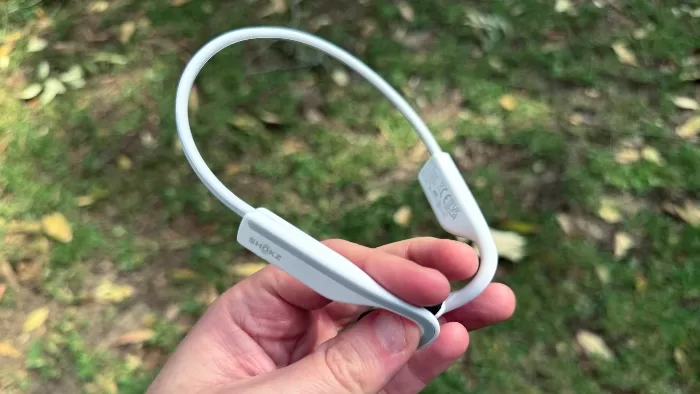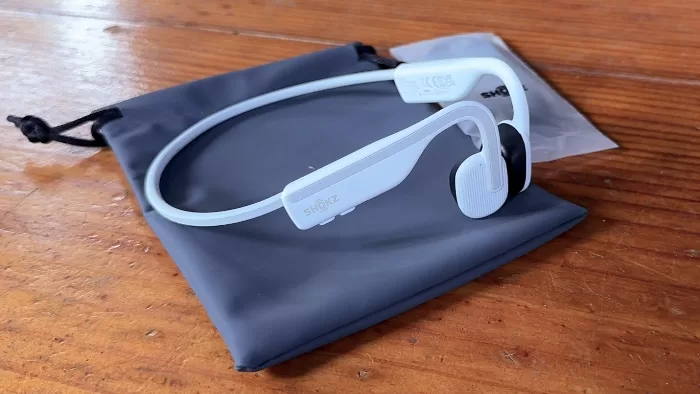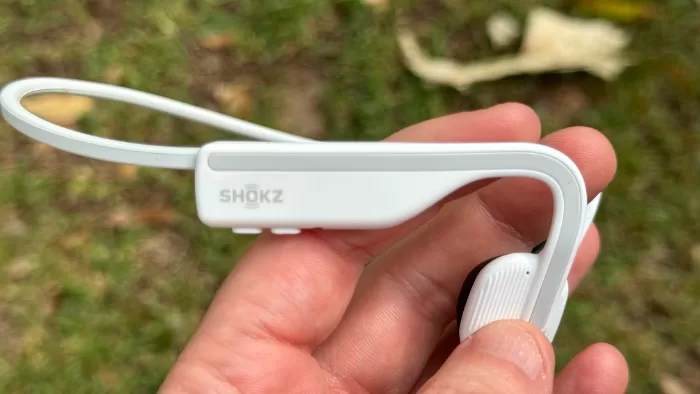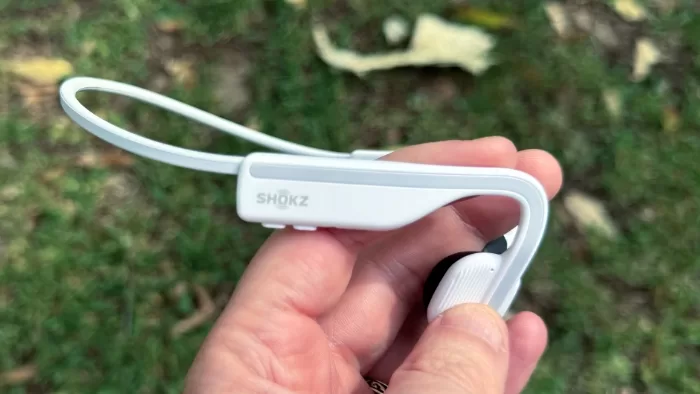
The Shokz OpenMove Headphones provide always-aware audio at a lower price point than their Pro counterparts – but I’d much rather have the Pro models for comfort and audio quality.
| Pros | Cons |
|---|---|
| Lower asking price | Lower audio quality |
| Always aware of what’s around you | Less comfortable fit than the Pro or OpenFit |
| Simple USB-C charging | Every BEEPING action involves BEEPING |
Score: 3/5
 |
Buy The Shokz OpenMove! | Buy On Amazon |
I’ve been busy running in training for the May 50K (where I’ll be running 100km, you can sponsor me here if you’re so inclined), which means it’s been rather handy to have a few pairs of running-specific Bluetooth headphones to hand. Having already put the Shokz OpenFit and Shokz OpenRun Pro headphones through their paces, I then turned to the significantly older and significantly more affordable Shokz OpenMove headphones.
Affordability is great in these times of rising costs, but as is so often the case with more budget-centric products, there are tradeoffs to consider. The Shokz OpenMove do cover the job they’re meant for, providing exercise-centric wireless bone conduction audio while you’re exercising, but they are beset with a few problems that I really didn’t hit with the more premium-priced OpenFit or OpenRun Pro models.
Also read:
Shokz OpenFit Headphones Review
Shokz OpenRun Pro Review
In this review
Shokz OpenMove Specifications
Shokz OpenMove Design
Shokz OpenMove Installation
Shokz OpenMove Performance
Shokz OpenMove Battery
Shokz OpenMove Conclusion
Design

Like the OpenRun Pro, the Shokz OpenMove are built in classic “fitness headphone” style, with a connected band that wraps around the back of your head connected to two earpieces. However, unlike most other bud-style headphones, these use bone conduction to transmit audio outside of your actual ears, so you never actually put buds in your ears to speak of.
Also like the OpenRun Pro, the Shokz OpenMove headphones have a stiff but flexible band rather than just a cable. That’s a style I very much preferred when testing out the OpenRun Pro, because I find the looser cable style of other headphones quickly becomes an irritant and a distraction when I’m out running. More on this below in the performance section.
The Shokz OpenMove are considerably cheaper than the Shokz OpenRun Pro headphones, however, and this is quickly evident when you get them out of the box, thanks to their plastic construction. Shokz loaned me a pair in Alpine White, but they’re also available in Slate Grey, Elevation Blue or Himalayan Pink if that’s more to your style.
Along with the headphones themselves, you also get a soft carrying case and a simple USB-A to USB-C charging cable (but no charger) in the Shokz OpenMove box.
Installation

The Shokz OpenMove headphones are Bluetooth compliant, and the first time you fire them up they’re ready for Bluetooth pairing. This was easy across both Android and iOS platforms in my testing, and I was keen to see what kind of tweaking I could do with the existing Shokz app as well.
Turns out the answer to that question was absolutely nothing.
Newer Shokz headphones work with the Shokz App for features such as firmware updates and displaying battery capacity remaining, but the Shokz OpenMove aren’t detected by the app at all in any way.
That means no checking battery life, but also no firmware updates unless Shokz made an installer app that worked over USB-C to do so – and I’m far from certain that the power port on the Shokz OpenMove is data-compliant anyway!
It is at least simple, and if you want to pair with additional devices, that’s just a matter of a long press on the Shokz OpenMove’s power button.
Performance

Like the OpenFit and OpenRun Pro headphones, the Shokz OpenMove headphones use an open bone conduction microphone that sits outside of your ear. The advantage here is greater situational awareness, because all of the actual sounds of the world around you, like that speeding idiot Sydney driver who desperately wants to flatten all runners – maybe that’s just a “me” thing, but I doubt it – so you can dodge out of the way and stay safe while staying fit.
The disadvantage here is an audio one, because this kind of approach by design can’t quite have the same level of isolation, leading to audio that feels a little more (if I may date myself badly for a second) like AM radio more than anything else. Or, I guess, low bitrate mp3 if that analogy means little to you?
At a specifications level there’s not much between the Shokz OpenMove and the Shokz OpenRun Pro headphones, but I was surprised at just how much of an audio difference I experienced in day to day use, especially when running.
The issue here I suspect isn’t so much the actual speakers, but instead how they wrap around my head and move just a little more than their Pro counterparts did. There’s a definite “sweet spot” for audio throughput through my skull, and when the Shokz OpenMove shift from that, the audio quality notably dips.
I could get around that a little bit by pumping up the volume, although this also highlights another “feature” of Shokz headphones I’m not a big fan of. Every single action is accompanied by a loud beeping noise. Want to put the volume up? BEEP. Want it a little louder with a second press? BEEP. Too loud now so you need to dial it down? BEEP BEEP BEEP.
Yeah, I’m not a fan of excessive beeping.
The other issue I hit with the Shokz Openmove was one of comfort. The Shokz OpenMove are actually the same weight as the Shokz OpenRun Pro headphones at 29g, but they felt a lot heavier during and after a running session, again most likely down to their plastic construction. That movement around my ears was more pronounced, and each bounce led to less comfort than their pricier counterparts after a run.
If you’re also going to be taking calls on the Shokz OpenMove, that function works fairly well, though I did find in every case that the ideal audio volume I had for running was way too loud for actual calls, leading to a need to quickly dial down microphone volume while in calls.
Battery

One factor I really didn’t like with the Shokz OpenRun Pro was the use of a custom magnetic charging cable, because that kind of proprietary charger almost inevitably breaks or gets lost over time.
It was a pleasant surprise then to discover that the Shokz OpenMove simply use USB-C instead. There’s no charger in the box, just a cable, and charge time is longer than for the other Shokz headphones I’ve reviewed previously. Still, I’d rather have USB-C, where I have loads of cables and compliant chargers than anything of a custom nature.
Shokz rates the battery life of the Shokz OpenMove as running for up to 6 hours, which is roughly 5 hours more than I could go outside and run for – but thankfully you don’t actually have to be exercising for this kind of feature to be tested.
That’s a fair figure based on my testing, though it’s not quite as much as competing fitness models, or even some straight true wireless buds I’ve tested previously.
Shokz OpenMove: Alex’s Verdict

There’s always a danger when reviewing the budget counterpart to a really fancy gadget, because of course the fancier model will seem “nicer”. There would be something badly wrong if that wasn’t the case.
However, having just come off the Shokz OpenRun Pro, I can all too easily see where Shokz made changes with its approach and design, and where the Pro models are just far more appealing to me.
The Shokz OpenMove are perfectly fine at the job they’re designed to do, but the dip in audio quality and comfort levels is quite noticeable. If all you want is audio and you absolutely must have that open ear approach they’ll get the job done – but I’d much rather strap a set of Shokz OpenRun Pro to my head for my next workout session.
Shokz OpenRun Pro: Pricing and availability
The Shokz OpenRun Pro headphones retail in Australia for $129
 |
Buy The Shokz OpenMove! | Buy On Amazon |
Was this review useful to you? Support independent media by dropping a dollar or two in the tip jar below!









